Coleman Bayside Handleiding
Bekijk gratis de handleiding van Coleman Bayside (3 pagina’s), behorend tot de categorie Tent. Deze gids werd als nuttig beoordeeld door 95 mensen en kreeg gemiddeld 4.8 sterren uit 48 reviews. Heb je een vraag over Coleman Bayside of wil je andere gebruikers van dit product iets vragen? Stel een vraag
Pagina 1/3

BAYSIDETM 6 TENT MODEL 2000005494
Attach frame clips along edges of tent to the Main & Side Poles. (Fig. 6)
Locate the straps with toggle & loop above closet at back of tent.
Wrap strap around black Main Poles where they cross; then insert
toggle through loop to secure. (Fig. 7)
Stretch tent until taut, then secure metal loops and web straps
located on all sides and corners of tent with stakes. (Fig. 8)
Pole Descriptions
Pole Pole Pole
Description Qty. Dia. Repair Kit Replacement Kit
Main Pole, black, thick 2 9.5mm 5010000540 5010000548
Front Pole, black with
green center insert 1 9.5mm 5010000540 5010000548
Side pole, black with
blue center insert 2 8.5mm 5010000541 5010000547
Rainfly Pole, black with
red center insert 1 8.5mm 5010000541 5010000547
Insert end of Main Poles (black, thick) into pins located in the front
corners of the tent. (Fig. 2 & 4)
Go to opposite end of each Main Pole and gradually apply pressure
to each forming arches. Insert the pin located at the outside corners
of the closet at the back of tent into each pole end. (Fig. 2 & 4)
Insert end of each Side Pole (black with blue center insert) into pin
located on the sides of the tent. (Fig. 3 & 4)
Go to opposite end of each Side Pole and gradually apply pressure
to form an arch. Insert the pin into pole end at the inside corners of
the closet. (Fig. 3 & 4)
(continued on other side)
Pin for
Main Pole (black,
thick) at outside
corners of closet
Pin for Side Pole (black
with blue center insert)
at inside corners of
closet
Pin for Main Pole (black,
thick) at front
corners of tent
Pin for Side Pole (black with
blue center insert) at sides
of tent
Insert end of Front Pole (black with green center insert) (above door)
into remaining pin located on the side of the tent. (Fig. 5 & 5A)
Go to opposite end of Front Pole and gradually apply pressure to
form an arch. Insert the pin into pole end at the opposite side of
tent. (Fig. 5 & 5A)
Front of Tent
Door
Front Pole (black with
green center insert)
above door
To Attach Rainfly
Drape Rainfly over tent with maroon vestibule flaps located at the
front of the tent (see Fig. 9 on other side of this tag).
Hook and loop fasteners, located on seams of underside of
Rainfly, should be centered over black Main Poles.
Before you begin
Read all instructions before set up.
Select a level site clear of rocks, branches, and other hard or sharp objects, •
to install your tent.
WARNING: Keep clear of overhead power lines.
Do not set up your tent under trees because of potential lightning strikes or •
falling tree limbs in inclement weather.
Secure with • all stakes and guylines provided to prevent property damage or
personal injury.
For best results in windy conditions, position narrow end of tent into the wind.•
Enlist the help of at least one other person to assist you when it is time to •
assemble the tent.
To Set Up Tent
Unfold tent and spread out on a clean, level surface with the door
facing the desired direction. (Fig. 1)
Assemble all poles by interlocking the shock-corded,
sections together.
Insert long, black Main Poles through the black trimmed sleeves on
top of tent forming an X”. (Fig. 1)
Insert front pole with green center insert through the green
trimmed sleeve located above door. (Fig. 1)
Insert shorter, black Side Poles with blue center insert through the
blue trimmed sleeves. (Fig. 1)
Door
Front of Tent
Main Poles (black, thick)
Front Pole
(black with
green center
insert)
Side Pole (black with
blue center insert) Side Pole (black with
blue center insert)
Closet
Pin for Side Pole
(black with
blue center
insert)
Pin for
Side Pole
(black with
blue center
insert)
Pin for Main Pole (black, thick)
Pin for Main Pole (black, thick)
Insert end of Rainfly Pole into pin on either
side of front door. (Fig. 10)
Go to opposite end of Rainfly Pole and
gradually apply pressure to form an arch.
Insert the pin into pole end at other side of
the door. (Fig. 10 & 13)
Locate all hook & loop fasteners on
underside of Rainfly and wrap around all
Main Poles, Side Poles & Rainfly Pole to
secure. (Fig. 11)
Insert the Rainfly Pole (black with red center insert) through sleeve with
red trim on underside of Rainfly above front door of tent. (Fig. 9)
Sleeve with Red Trim
Rainfly Pole (black
with red center insert)
Rainfly
Front of Tent
Door
Vestibule Flap
Vestibule Flap

To Store
All poles and stakes must be placed in the storage bag to prevent
damage to the fabric items placed in the carry case.
Make sure tent is clean and dry before placing in carry case.
Remove rainfly, spread out on floor of tent, then unzip door & vents
before taking tent down for storage.
Neatly fold tent to width of pole storage bag, place on tent, roll
tightly, and place in carry case.
Store in a clean, dry area.
Electrical Cord Access
Unzip access panel in the lower left front
corner of tent and bring in electrical cord.
Use only UL approved cords that are rated
for outdoor usage. (Fig. 18)
Cooler Access
The smaller zippered opening at the rear of tent is designed for added
ventilation and easy access to your
beverage cooler.
To use as a vent, unzip flap to
expose screen.
To use as a cooler access, unzip
other flap to make an avenue to
bring beverages into tent. (Fig. 19)
Door and Window Vents
For better ventilation, unzip
flap on door, roll down, and
insert toggle into fabric loop
to secure. (Fig. 16)
To open window vents for
more ventilation, unzip, then
roll up and insert toggles
through fabric loops. (Fig. 17)
Storage Closet in Tent
The storage closet, located at the back of the tent, is intended for
keeping smaller items out of the way and off the floor of the tent.
(Fig. 14)
Heavier items may cause damage to fabric shelves or the
tent fabric.
To attach the closet cover, insert toggles through fabric loops.
(Fig. 15 & 15A)
Things You Should Know:
Under certain conditions (cold weather, high humidity, etc.) condensation •
will form on the inside of your tent. Condensation is caused by water
vapor from your breath, perspiration, or any wet clothing inside the
tent. It is NOT LEAKAGE through the tent fabric. It can be minimized by
removing wet clothing from your tent and by providing good ventilation
through the tent.
Tree limbs, tree sap, bird droppings, or moisture steadily dripping off tree •
limbs can cause damage to the tent fabric and its coating resulting in
leaks or loss of flame-resistant properties.
Never store tent, even for a short period of time, without drying it •
thoroughly and brushing off caked dirt. Do not pack stakes or poles
inside your tent. Use a separate storage bag.
Stakes should be removed by pulling on the stake itself. NEVER PULL ON •
THE TENT TO REMOVE STAKES AS THIS COULD RESULT IN PROPERTY
DAMAGE OR PERSONAL INJURY.
Tent poles should not be left telescoped together during storage.•
Do not leave your tent set-up for weeks at a time. Be aware that •
exposure to ultraviolet rays from the sun can seriously damage material
and/or cause it to become discolored.
WARNING: Keep all flame and heat sources away from this tent
fabric.
This tent meets the flammability requirements of CPAI-84. The
fabric will burn if left in continuous contact with any flame source.
The application of any foreign substance to the tent fabric may
render the flame-resistant properties ineffective.
TheColemanCompany,Inc.•3600NorthHydraulic•Wichita,Kansas67219
1-800-835-3278intheUnitedStates•www.coleman.com
SunbeamCorporation(Canada)Limited•DBAJardenConsumerSolutions
20BHerefordStreet•Brampton(Ontario)L6Y0M1
1800387-6161inCanada•www.coleman.com
MADE IN BANGLADESH PRINTED IN BANGLADESH
2009 The Coleman Company, Inc.
Coleman®, , , are registered trademarks and is a trademark of
The Coleman Company, Inc.
Stretch elastic straps and hook clip on each to the metal loops at
the front, back, and sides of the
tent. (Fig. 12 & 13)
Extend out vestibule flaps
and secure with metal stakes
through the loops in the web
straps. (Fig. 13 & 13A)
Stretch guylines until taut, then
secure with stakes. (Fig. 13 & 13B)
To Attach Rainfly (continued)

TENTE BAYSIDE
TM
6 MODÈLE 2000005494
Description des mâts
Diam. Nécessaire Ens. de
Désignation Qté mât de réparation remplacement
Mât principal, noir, épais 2 9,5 mm 5010000540 5010000548
Mât avant, noir avec
insertion centrale verte 1 9,5 mm 5010000540 5010000548
Mât latéral, noir avec
insertion centrale bleue 2 8,5 mm 5010000541 5010000547
Mât de double toit, noir,
insertion centrale rouge 1 8,5 mm 5010000541 5010000547
Montage de la tente
Dépliez et étalez la tente sur une surface propre et d’aplomb.
Orientez l’entrée dans la direction désirée. (Fig. 1)
Assemblez tous les mâts en emboîtant leurs sections
solidarisées.
Enfilez les longs mâts principaux noirs dans les passants du haut
de la tente; ils sont garnis de noir et se croiseront. (Fig. 1)
Enfilez le mât avant (noir, à insertion centrale verte) dans le
passant garni de vert qui se trouve au-dessus de l’entrée. (Fig. 1)
Enfilez les mâts latéraux (noirs, à insertion centrale bleue) dans les
passants garnis de bleu. (Fig. 1)
Attachez le double toit
Étalez le double toit sur la tente, en plaçant les rabats bordeaux de
l’abside à l’avant de la tente (voyez la fig. 9 au verso).
Les attaches velcro (aux coutures de l’envers du
double toit) devraient être centrées sur les mâts principaux noirs.
Avant de commencer
Lisez toutes les instructions avant d’entreprendre le montage.
Choisissez l’emplacement où vous monterez votre tente: plat, sans pierres, •
branches ou autres objets pointus.
AVERTISSEMENT: Éloignez la tente des lignes électriques aériennes.
Ne montez pas la tente sous les arbres afin d’éviter les risques de •
foudroiement ou de branches qui tombent par gros temps.
Immobilisez la tente avec • tous les piquets et haubans prévus pour éviter
les dommages matériels et les blessures corporelles.
Pour obtenir les résultats optimaux quand il y a du vent, mettez la partie •
la plus étroite de la tente au vent.
À deux ou plus, c’est mieux – demandez à une ou à plusieurs personnes •
de vous aider à assembler la tente.
Avant de la tente
Mât avant noir à inser ( -
tion verte )
au-dessus de l’entrée
(suite au verso)
Introduisez un bout de chaque mât principal (noir, épais) sur une
cheville d’un coin avant de la tente. (Fig. 2 et 4)
Allez au bout opposé de chaque mât principal et arquez progres-
sivement le mât. Insérez la cheville se trouvant aux coins extérieurs
du placard, à l’arrière de la tente, dans le bout des mâts. (Fig. 2 et 4)
Introduisez un bout de chaque mât latéral (noir à insertion centrale
bleue) sur une cheville des côtés de la tente. (Fig. 3 et 4)
Allez au bout opposé de chaque mât latéral et arquez progres-
sivement le mât. Insérez la cheville des coins intérieurs du placard
dans le bout des mâts cintrés. (Fig. 3 et 4)
Avant de la tente
Mâts principaux (noirs, épais)
Mât avant
(noir, insertion
centrale
verte)
Mât latéral (noir, insertion
centrale bleue) Mât latéral (noir, insertion
centrale bleue)
Placard
Cheville pour
mât latéral
(noir, insertion
centrale bleue)
Cheville pour
mât latéral
(noir,
insertion
centrale
bleue)
Chevilles pour mâts
principaux (noirs, épais)
Chevilles pour mâts principaux (noirs, épais)
Placard
Cheville
pour mât principal
(noir, épais) aux
coins ext. du placard
Cheville pour mât
latéral (noir à insertion
centrale bleue) aux coins
intérieurs du placard
Cheville pour mât principal
(noir, épais) aux coins
avant de la tente
Cheville pour mât latéral
(noir à insertion bleue) sur
les côtés de la tente
Attachez les crochets d’armature des bords de la toile aux mâts
principaux et aux mâts latéraux. (Fig. 6)
Repérez les sangles à olive au-dessus du placard, à l’arrière de la
tente. Enroulez les sangles autour des mâts principaux noirs, là où
ils se croisent; immobilisez sûrement avec l’olive. (Fig. 7)
Étirez la tente pour bien la tendre et ancrez les bagues de métal et
sangles des coins et des côtés de la tente avec des piquets. (Fig. 8)
Introduisez le bout du mât avant (noir à insertion verte) au-dessus de
la porte sur la cheville restante du côté de la tente. (Fig. 5 et 5A)
Allez au bout opposé du mât avant et arquez progressivement
le mât. Introduisez alors la cheville dans le bout du mât, du côté
opposé de la tente. (Fig. 5 et 5A)
Mettez un bout du mât sur une cheville, d’un
côté ou de l’autre de l’entrée. (Fig. 10)
Allez au bout opposé du mât et arquez le
mât progressivement. Dans le bout libre
du mât, insérez la cheville qui se trouve de
l’autre côté de la porte. (Fig. 10 et 13)
Enroulez les attaches velcro (sur la face
envers du double toit) autour des mâts
principaux, des mâts latéraux et du mât du
double toit ; immobilisez-les. (Fig. 11)
Passant garni de rouge
Mât du double toit (noir
à insertion rouge)
Double toit
Avant de la tente
Rabat de l’abside
Rabat de
l’abside
Entrée
Enfilez le mât du double toit (noir à insertion rouge) dans le passant
garni de rouge de la face envers du double toit, au-dessus de la porte
d’entrée de la tente. (Fig. 9)
Product specificaties
| Merk: | Coleman |
| Categorie: | Tent |
| Model: | Bayside |
Heb je hulp nodig?
Als je hulp nodig hebt met Coleman Bayside stel dan hieronder een vraag en andere gebruikers zullen je antwoorden
Handleiding Tent Coleman

17 November 2024

17 November 2024

22 Juni 2023

20 Juni 2023

19 Juni 2023

19 Juni 2023

15 Juni 2023

15 Juni 2023

14 Juni 2023

14 Juni 2023
Handleiding Tent
- Woods
- MSR
- Holtkamper
- Nomad
- Vrijbuiter
- Gazebo Penguin
- SereneLife
- Kelty
- Grand Canyon
- Eureka
- TOOLPORT
- Isabella
- Khyam
- Edges
- Step2
Nieuwste handleidingen voor Tent
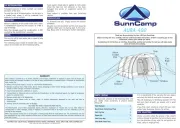
1 September 2025
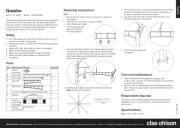
15 Juli 2025
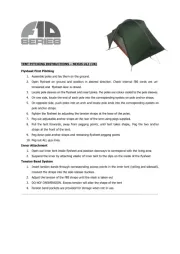
14 Juli 2025
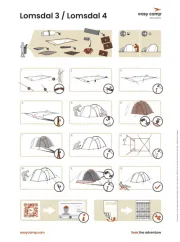
14 Juli 2025
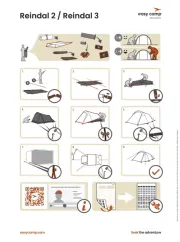
14 Juli 2025
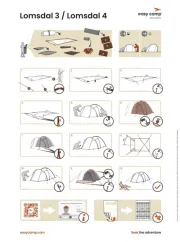
14 Juli 2025

6 Juli 2025
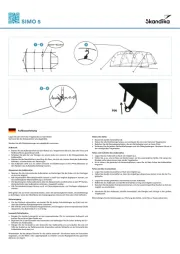
5 Juli 2025
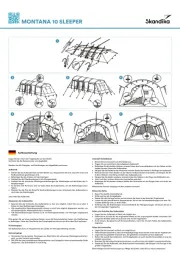
2 Juli 2025
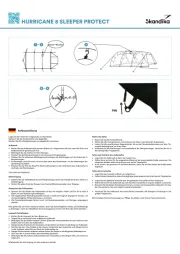
2 Juli 2025